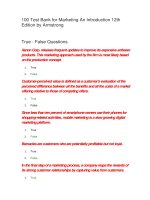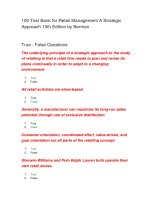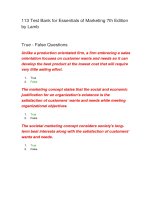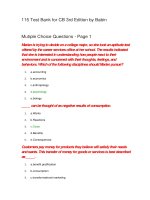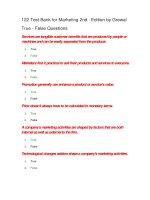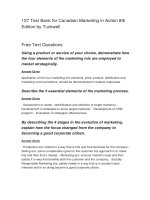156 test bank for marketing 2nd edition by grewal đề trắc nghiệm marketing
Bạn đang xem bản rút gọn của tài liệu. Xem và tải ngay bản đầy đủ của tài liệu tại đây (241.33 KB, 47 trang )
156 Test Bank for Marketing 2nd Edition by Grewal
True - False Questions
During the past decade or so, marketers have begun to realize that they
need to think about their customer orientation in terms of transactions
rather than relationships.
1.
True
2.
False
Value-based marketing supports developing long-term customer loyalty.
1.
True
2.
False
In value-based marketing firms, the economics department is responsible
for coordinating all aspects of supply and demand.
1.
True
2.
False
Thoughts, opinions, philosophies and intellectual concepts fit the
concepts of neither goods nor services, and they cannot really be
marketed.
1.
True
2.
False
Marketing is an activity that only large firms with specialized departments
can use.
1.
True
2.
False
Value is what you get for what you give.
1.
True
2.
False
Google, Facebook and YouTube are all innovative, and each company has
succeeded because it provided value to its customers.
1.
True
2.
False
Good marketing is not a random activity.
1.
True
2.
False
The four Ps include persistence, promotion, presence, and performance.
1.
True
2.
False
The group of firms that makes and delivers a given set of goods and
services is known as a supply chain.
1.
True
2.
False
Understanding a market's needs and wants is fundamental to marketing
success.
1.
True
2.
False
The goals of marketing promotion are youth, style, and sex appeal.
1.
True
2.
False
Marketers in a number of major food manufacturers have acted to restrict
advertising to children in response to public concerns about obesity in
children and the impact of advertising fast food.
1.
True
2.
False
In co-creation, the customer is involved as a collaborator in the creation of
a product or service, which provides additional value to the customer.
1.
True
2.
False
Marketers would prefer to sell their products and services to everyone but
it is not practical to do so.
1.
True
2.
False
Multiple Choice Questions - Page 1
UPS requires their delivery people to wear uniforms and washes their
trucks nightly so they are always clean. Part of the reason this service
company created these policies is because they recognize:
1.
A. consumers want friendly delivery people.
2.
B. their competitors did not do this.
3.
C. consumers' image of the benefits they receive are tied to their image of the
producer.
4.
D. the goods UPS sells are easily replicated.
5.
E. all of the above
The marketing goal of getting the "right quantities to the right locations, at
the right time" is:
1.
A. communicating the value proposition.
2.
B. supply chain management.
3.
C. creating value.
4.
D. capturing value.
5.
E. price and performance management.
Brian is struggling with the choice of publishing his new book, "How to
cook Polish Barbeque" as an e-book or a paperback. Brian is addressing
which core marketing aspect?
1.
A. satisfying customer needs and wants.
2.
B. exchange function of marketing.
3.
C. making product decisions.
4.
D. decisions regarding in which setting marketing takes place.
5.
E. making pricing decisions.
Whenever Jami calls on his building contractor customers he asks if they
are having any problems. In doing so, Jami is addressing which of the
following core aspects of marketing?
1.
A. satisfying customer needs and wants.
2.
B. exchange function of marketing.
3.
C. product, place, promotion, and price decisions.
4.
D. decisions regarding in which setting marketing takes place.
5.
E. creating value objective of marketing.
Local television advertising often includes ads for automobiles
dealerships using actors trying to create a sense of excitement and
urgency among consumers. These ads are attempting to achieve the
promotional goal of _____________ potential buyers.
1.
A. informing
2.
B. persuading
3.
C. reminding
4.
D. all of the above
5.
E. none of the above
In most supermarkets there are numerous almost identical products,
some with brand names and others with store or generic labels. In terms
of creating product value, the basic difference between branded and
generic products is:
1.
A. brand image.
2.
B. intrinsic ingredients.
3.
C. price.
4.
D. all of the above.
5.
E. none of the above.
When referring to "exchange," marketers are focusing on:
1.
A. location where products and services are traded.
2.
B. price charged adjusted for currency exchange rates.
3.
C. creating value.
4.
D. promotional offers designed to stimulate barter.
5.
E. the trading of things of value.
The importance of supply chain management is often overlooked
because:
1.
A. it is considered boring.
2.
B. pricing strategy is more fun.
3.
C. companies do not want organization members to understand the problems
involved.
4.
D. many of the activities take place behind the scenes.
5.
E. all of the above.
Whenever Valerie has a new massage therapy customer, she asks the
person if they want to be on her e-mail distribution list. In the process, in
addition to exchanging her massage therapy service for payment, Valerie
is gathering:
1.
A. information.
2.
B. promotional effective analysis.
3.
C. pricing data.
4.
D. value.
5.
E. all of the above
Of primary interest to marketers are ___________________ buyers.
1.
A. centrally controlled
2.
B. unqualified and underserved
3.
C. qualified potential
4.
D. past unsatisfied
5.
E. future potential
Marketing involves all of the following EXCEPT:
1.
A. exchange
2.
B. satisfying customer needs and wants
3.
C. creating value
4.
D. efforts by individuals and organizations
5.
E. production scheduling
Marketing traditionally has been divided into a set of four interrelated
decisions known as the marketing mix, or four Ps, including all of the
following EXCEPT:
1.
A. product
2.
B. place
3.
C. performance
4.
D. promotion
5.
E. price
Xavier is analyzing potential market segments. He knows he has to
carefully seek potential customers who have both an interest in his
products and:
1.
A. the intellectual capability to comprehend his promotional message.
2.
B. the ability to buy them.
3.
C. knowledge of competing offers.
4.
D. the ability to negotiate discounts.
5.
E. are removed from traditional market exchange alternatives.
________________ is communication by a marketer that informs,
persuades, and reminds potential customers.
1.
A. Pricing
2.
B. Promotion
3.
C. Placement
4.
D. Product value creation
5.
E. Pork barreling
Which of the following questions must be addressed when making
marketing decisions?
1.
A. How is the product to be designed?
2.
B. How much should the product cost?
3.
C. Where should the product be promoted?
4.
D. How will the product be delivered to the customer?
5.
E. All of the above
Marketers involved in supply chain management are constantly balancing
the:
1.
A. goal of promotional effectiveness against ethical advertising standards.
2.
B. problem of price maximization against cost efficiency.
3.
C. goal of minimizing costs against satisfying the service levels customers expect.
4.
D. desire to achieve against the need for a stabile source of supply.
5.
E. goal of efficiency against the goal of profit minimization.
Which of the following is a core aspect of marketing?
1.
A. satisfying the firm's wants and needs.
2.
B. creating universal coverage
3.
C. instilling self-sufficiency
4.
D. making product, place, promotion, and price decisions
5.
E. all of the above
The basic difference between a good and a service is a good:
1.
A. provides intangible benefits.
2.
B. can be physically touched.
3.
C. always less expensive than a corresponding service.
4.
D. generates greater interest among consumers.
5.
E. depreciates more rapidly in the minds of consumers.
Which of the following activities does NOT involve marketing?
1.
A. purchasing gasoline
2.
B. attending marketing class
3.
C. downloading music
4.
D. deciding how many hours to sleep
5.
E. all of the above
Marketers must determine the price of a product carefully on the basis of
the potential buyer's belief about:
1.
A. its value.
2.
B. the environment.
3.
C. advertising.
4.
D. monetary policy.
5.
E. external stimuli.
Four Winds Art Gallery recently began offering appraisals of customers'
art collections. Four Winds is:
1.
A. expanding from offering just service to also offering goods.
2.
B. implementing a market segmentation strategy.
3.
C. capturing value through multiple pricing strategies.
4.
D. expanding from offering just goods to also offering services.
5.
E. increasing customer value through inflated appraisal evaluations.
Julia is considering a career in marketing. She is concerned about the
image of marketers as fast-talking, high-pressure people. When reading
about the core aspects of marketing, Julia is relieved to see that in
marketing,
1.
A. all parties to an exchange should be satisfied.
2.
B. promotion is foremost, followed by pricing decisions.
3.
C. decisions are made regarding how a product is designed.
4.
D. customers are not needed until the product is ready for sale.
5.
E. distribution is controlled by customers.
Delivering the value proposition is also known as:
1.
A. endless chain marketing.
2.
B. situational distribution efficiency.
3.
C. wholesaling.
4.
D. marketing myopia.
5.
E. supply chain management.
Supply chain management involves integrating the efforts of:
1.
A. suppliers.
2.
B. manufacturers.
3.
C. warehouses.
4.
D. stores.
5.
E. All of the above.
The four Ps comprise the marketing mix, which is the ______________ set
of activities that the firm uses to respond to the wants of its target
markets.
1.
A. reversible
2.
B. external
3.
C. organic
4.
D. controllable
5.
E. global
Every Christmas season, Anheuser-Busch runs television ads featuring
Clydesdale horses in a winter scene. These ads focus on the promotional
goal of __________ consumers about the company's brand.
1.
A. informing
2.
B. persuading
3.
C. reminding
4.
D. all of the above
5.
E. none of the above
Smart marketers recognize that when exchanges take place with their
customers, whether in person or electronically, it is an opportunity to:
1.
A. demonstrate the limitations of competitors' offerings.
2.
B. gather information.
3.
C. offer discounts.
4.
D. investigate alternative distribution system stimuli.
5.
E. design new product offerings for other market segments.
Some discount stores put products in large bins and let consumers hunt
and find bargains. Part of the price these consumers pay is:
1.
A. cost of providing the bins.
2.
B. the value of their time and energy.
3.
C. excitement they experience in finding an item they desire.
4.
D. the savings to the store of not having to display the products neatly on shelves.
5.
E. all of the above
When considering career choices in marketing, many students overlook
supply chain management because:
1.
A. it is considered too quantitative.
2.
B. promotion strategy is more fun.
3.
C. companies do not want organization members to understand the problems
involved.
4.
D. it only takes place in large, urban areas.
5.
E. many of the activities take place behind the scenes.
UPS, FedEx, and DHL all support other companies' _______________
marketing goal.
1.
A. supply chain management
2.
B. pricing
3.
C. product value
4.
D. promotional effectiveness
5.
E. none of the above
The owner of The House Doctor, a home repair business, often helped
potential customers evaluate alternative ways to fix problems. Since he
got paid for materials and labor when doing repairs, the House Doctor:
1.
A. was only offering a product.
2.
B. was offering only a service.
3.
C. provided both a service and a product.
4.
D. was primarily a marketer of ideas.
5.
E. focused on supply chain management.
Henriette offers financial counseling and management on a fee-only basis.
She has found that different customers are willing to pay different rates
for her service. Henriette recognizes that her pricing decisions primarily
depend on:
1.
A. regulations determining the fees financial advisors can charge.
2.
B. changes in technology allowing consumers to manage their own affairs.
3.
C. how much customers are willing to pay and are satisfied with their purchase.
4.
D. changes in the economy creating recessions or periods of expansion.
5.
E. how much effort she has to expend in assisting her clients.
Fiona has developed a new software application that automatically
reconfigures accounting information based on the standards used in each
country. Her product is superior to anything that exists on the market.
Which of the following questions will she have to address when making
marketing decisions?
1.
A. How the software will be promoted?
2.
B. What price to charge?
3.
C. What distribution channels to use?
4.
D. Where to introduce the software?
5.
E. All of the above
Marketing efforts designed to get the product or service to the right
customer, when that customer wants it, are called:
1.
A. supply chain management.
2.
B. situational distribution efficiency.
3.
C. wholesaling.
4.
D. marketing myopia.
5.
E. endless chain marketing.
Marketing includes offering:
1.
A. products
2.
B. services
3.
C. ideas
4.
D. combinations of products, services, and ideas
5.
E. none of the above.
Ellen's firm has been installing home entertainment systems for ten years.
In a new approach, she has started selling a line of imported speakers that
offer superior value to her customers when they upgrade their systems.
Ellen should focus her marketing efforts on:
1.
A. the service she provides to customers.
2.
B. the new merchandise.
3.
C. a combination of the services and the merchandise.
4.
5.
D. the speakers until they become profitable than return her focus to the core of
her business – the installation.
E. None of the above. She should focus on improving the installation.
The fundamental goal of marketers when creating goods, services, or
combinations of both, is to:
1.
A. differentiate themselves from the competition.
2.
B. overwhelm consumers.
3.
C. provide what is needed as defined by government regulations.
4.
D. stimulate short-term sales.
5.
E. create value.
Yesenia, the new university course scheduling manager, is struggling with
adjustments to the fall schedule. She is trying to determine how to offer
what the students need at the times students need them. Yesenia is
struggling with the marketing function of:
1.
A. communicating the value proposition.
2.
B. supply chain management.
3.
C. creating value.
4.
D. capturing value.
5.
E. tormenting students.
The goal of promotion is to _______________ potential buyers about a
product or service.
1.
A. inform
2.
B. persuade
3.
C. remind
4.
D. all of the above
5.
E. none of the above
The price of a product is:
1.
A. expressed in money terms.
2.
B. includes the time involved in the purchase decision.
3.
C. includes the effort and energy involved.
4.
D. is everything the buyer gives up.
5.
E. all of the above
113 Free Test Bank for Marketing 2nd Edition by
Grewal Multiple Choice Questions - Page 2
When preparing for and engaging in a job interview, potential employees
engage in marketing most closely associated with _______________
marketing
1.
A. consumer to business
2.
B. business to business
3.
C. consumer to consumer
4.
D. business to consumer
5.
E. all of the above
One of the benefits of value driven marketing is attention to customer
needs and wants will likely result in:
1.
A. recessions
2.
B. increased competition
3.
C. long-term loyalties.
4.
D. stronger relational dialogues among competing firms in the marketplace.
5.
E. all of the above
Some customers will seek to get a lot of merchandise for a small amount
of money. In marketing, this is known as:
1.
A. the marketing paradox.
2.
B. the outer limits of pricing
3.
C. customers seeking value.
4.
D. profit pricing
5.
E. value variation
The "Got Milk" advertising campaign was designed to help market a(n):
1.
A. individual.
2.
B. firm.
3.
C. industry.
4.
D. organization.
5.
E. all of the above.
In 2006, the film Supersize Me provided a critical view of McDonalds
Company and their products. The company was caught off guard and had
to quickly develop a response. In terms of value-based marketing,
McDonalds faced the potential problem of:
1.
A. consumer perceptions change quickly.
2.
B. competitors constantly enter markets.
3.
C. global pressures continually reshape market opportunities.
4.
D. marketers understanding of consumers is complete.
5.
E. all of the above
Trey sells consumer electronics. He knows his customers weigh the costs
versus the benefits associated with the different options available. He
decides which products to offer and what prices to charge based on the
way his customers think. Trey operates in the _________ marketing era.
1.
A. production
2.
B. sales
3.
C. marketing
4.
D. value-based marketing
5.
E. all of the above
Janine has a new clothing design she would like to market. She knows
creating and delivering value to consumers is difficult and has seen
designers' successful products have been quickly replicated. For Janine,
the major problem she faces in creating and delivering value is most likely
to be:
1.
A. consumer perceptions change quickly.
2.
B. competitors constantly enter markets.
3.
C. global pressures continually reshape market opportunities.
4.
D. marketers' understanding of consumers is complete.
5.
E. all of the above
Joseph is about to graduate near the top of his class and has been
looking at some forward-thinking firms. He had expected the job market to
be tight, but found that some firms were using employment marketing to
attract the candidates they want and need. He noticed these firms used all
of the following approaches EXCEPT:
1.
A. using marketing research to understand what future employees want from a
position.
2.
B. using advertising agencies to focus creatively on the targeted job seekers.
3.
C. developing of an employee brand image.
4.
D. focusing on the GPA and courses students took in marketing and human
resources management.
5.
E. working to ensure the employment experiences match the candidates'
expectations.
To become a more value driven organization, Pokrah University is holding
coffee-hour discussions with its students and surveying its graduates
regarding students' educational needs and desires. Pokrah University is
becoming more value driven through:
1.
A. sharing information across their organization.
2.
B. balancing their customers' benefits and costs.
3.
C. evaluating strategic competitive partnerships.
4.
D. building relationships with customers.
5.
E. none of the above.
Value-based marketing depends on:
1.
A. knowing what the customer perceives as the key benefits of a product or
service.
2.
B. balancing customer benefits with reasonable costs.
3.
C. knowing what benefits customers would do without to keep prices down.
4.
D. looking at quality from the customer's perspective.
5.
E. All of the above.
As owner of a retail franchise food store, Mary Gray coordinates her
purchasing with specials advertised nationally throughout the franchise
system. One Monday she was surprised to find customers asking for
specials that she did not know about in advance. The franchise company
failed the value driven principle of:
1.
A. sharing information across the organization.
2.
B. balancing customers' benefits and costs.
3.
C. evaluating strategic competitive partnerships.
4.
D. building relationships with customers.
5.
E. none of the above.
By promoting perfume based on youth, style, and sex appeal, Calvin Klein
is attempting to:
1.
A. influence social norms regarding sexuality.
2.
B. increase price resistance.
3.
C. stimulate supply chain management cooperation.
4.
D. increase the perceived value of their products.
5.
E. none of the above.
Retailers accumulate merchandise from producers in large amounts and
sell to consumers in smaller amounts. Retailers function as:
1.
A. market intermediaries.
2.
B. monopolists.
3.
C. regulators of consumer demand.
4.
D. wholesaling specialists.
5.
E. intermediate promoters
Effective promotion enhances a product or service's:
1.
A. supply chain management system.
2.
B. wholesaling capabilities.
3.
C. perceived value.
4.
D. cost.
5.
E. all of the above
Adding Value 1.1: My M&Ms discusses a market approach similar to that
used by companies like Nike that allows customers to custom-design the
products. Marketers offering services also bring customers into the
design process to create custom approaches. This is known as:
1.
A. vanity product development
2.
B. value customization
3.
C. premium design
4.
D. value co-creation
5.
E. extreme customer service
As use of the Internet took off, car manufacturers were tempted to sell
directly to consumers but decided to maintain their existing dealer
networks. The car manufacturers considered switching from __________
to ____________ marketing.
1.
A. B2C; B2B
2.
B. B2C; A2Z
3.
C. B2B; B2C
4.
D. B2B; EDF
5.
E. ABC; XYZ
Many universities provide physical or electronic bulletin boards to
facilitate ride-sharing and exchange of used books among students.
These bulletin boards increase _________ marketing.
1.
A. B2C
2.
B. B2B
3.
C. A2C
4.
D. C2C
5.
E. underground
The traditional marketing channel through which consumers find and
purchase goods and services is known as:
1.
A. B2B
2.
B. C2C
3.
C. D2C
4.
D. C2D
5.
E. B2C
To become a better value driven organization, the manager of BestBulk
clothing store directed her staff to share information about:
1.
A. customers
2.
B. competitors
3.
C. complaints
4.
D. inventories
5.
E. all of the above
Melanie works for a small computer software company. Her boss is
constantly improving their products but neglecting customers, billing, and
promoting the company. Her boss is probably stuck in the _____________
era of marketing.
1.
A. production
2.
B. sales
3.
C. marketing
4.
D. value-based marketing
5.
E. all of the above
Value-driven marketers are constantly measuring the ___________ that
customers perceive against the cost of their offering.
1.
A. information
2.
B. benefits
3.
C. relationships
4.
D. perceptions
5.
E. misconceptions
In the past, manufacturer's representatives did not have up-to-minute data
about the products they were selling. Today, manufacturer's
representatives are often provided Intranet access to inventory data for
the companies they represent. Intranet systems allow companies to
become more value driven through:
1.
A. sharing information across the organization.
2.
B. balancing customers' benefits and costs.
3.
C. evaluating strategic competitive partnerships.
4.
D. building relationships with government regulators of marketing institutions.
5.
E. none of the above.
In delivering value, marketing firms attempt to find the most desirable
balance between:
1.
A. the need for value and the perception of value.
2.
B. explicit versus implicit value.
3.
C. providing benefits to customers and keeping costs down.
4.
5.
D. the desire to satisfy customers and the need to keep customers from running
the company.
E. the need for product improvement and the need for advertising.
The idea that a good product will sell itself is associated with the
_______________ era of marketing.
1.
A. production
2.
B. sales
3.
C. marketing
4.
D. value-based marketing
5.
E. all of the above
Henry Ford's statement, "Customers can have any color they want so long
as it's black," typified the ____________ era of marketing.
1.
A. production
2.
B. sales
3.
C. marketing
4.
D. value-based marketing
5.
E. all of the above
During the ______________ era, firms had excess capacity and used
personal selling and advertising to generate customers.
1.
A. production
2.
B. sales
3.
C. marketing
4.
D. value-based marketing
5.
E. all of the above
The evolution of marketing progressed along the continuum:
1.
A. sales, marketing, value-based marketing, production
2.
B. marketing, value-based marketing, production, sales
3.
C. value-based marketing, production, sales, marketing
4.
D. production, sales, marketing, value-based marketing
5.
E. sales, value-based marketing, marketing, production
The discussion of Zappos in the Power of Internet Marketing 1.1
demonstrates:
1.
2.
A. how increased promotion on the internet can be used to create value.
B. centralizing fulfillment operations is superior for a marketer because of the
enhanced inventory control.
3.
C. how the third P – Place – is becoming irrelevant is the emerging world of
internet commerce.
4.
D. how consumers are not particularly concerned about delivery and availability as
long as the product is stylish.
5.
E. how supply chain management is a critical component of marketing that creates
value for customers.
Value is:
1.
A. the lowest cost option.
2.
B. represented by brand names.
3.
C. the highest priced alternative.
4.
D. everyday low prices.
5.
E. what you get for what you give.
Fiona, the new manager of Common Ground Coffee House, is assessing
vendor performance, customer complaints, advertising effectiveness, and
all aspects of her business. Fiona recognizes value-based marketing:
1.
A. is based primarily on consumer perceptions.
2.
B. offers insights into competitor's actions.
3.
C. should be at the core of every firm's functions.
4.
D. depends on constantly changing global pressures.
5.
E. forces consumers to constantly change their perceptions.
Valerie's firm researched what employees are seeking, then
communicated a brand image for the firm and worked to ensure the
employee experiences matched what was advertised. The firm is using:
1.
A. human resources advertising.
2.
B. employee relations research
3.
C. human potential imaging
4.
D. employment marketing


